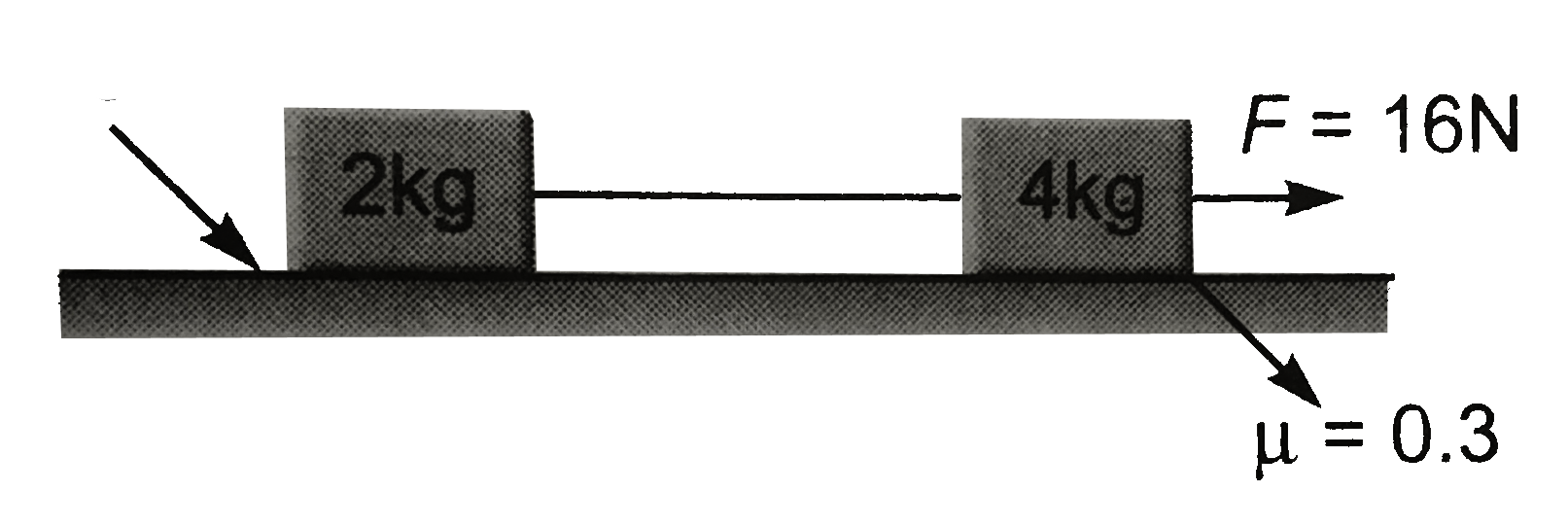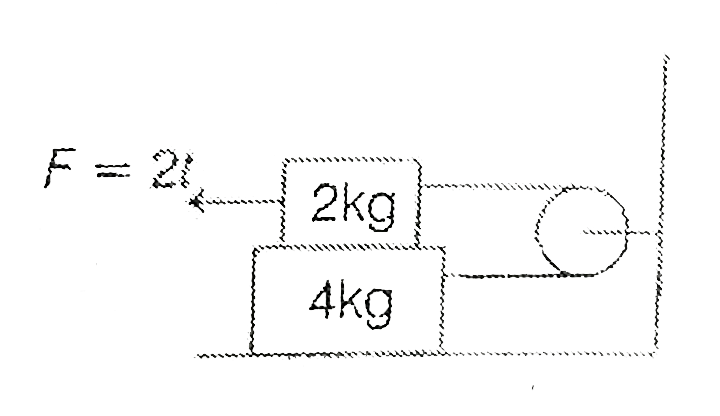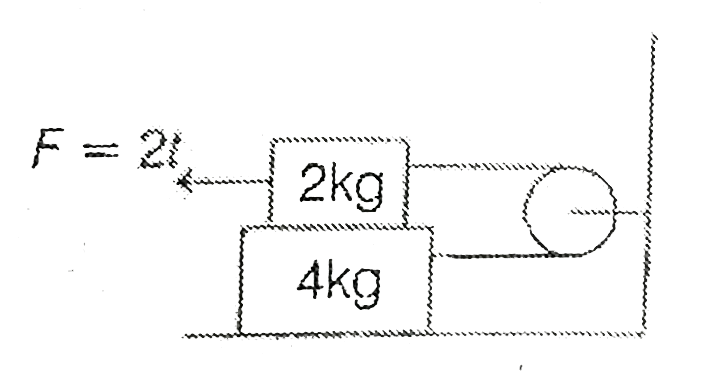The coefficient of friction between 4 kg and 5kg blocks is 0.2 and between 5kg block and grond is 0.1 respectively Choose the correct statements.

minimum force needed to cause system to move is 17 N
Whebn force is 4N static friction at all surfaces is 4 N to keep system at rest
Maximum acceleration of 4 kg block is 2ms2
Slipping between 4 kg and 5 kg blocks start when F is 17 N
The correct Answer is:C




So block Q is moving due to force while block P due to friction .
Friction direction on both +Q blocks as shown
first block Q will move and P will move with Q so by FBD taking P and Q as system
F−9=0⇒F=9N
When applied force is 4N then FBD
$ kg block is moving due to friction and maximum friction force is 8 N.
So acceleration =84=2ms2=amax.
Slipping will start at when Q has +ve acceleration equal to maximum acceleration of P, i.e., 2ms2.
F−17=5×2⇒F=27N.
Similar Questions
The coefficient of friction between 4kg and 5kg blocks is 0.2 and between 5kg block, ground is 0.1 respectively. The minimum force 'F' required for slipping between 4kg and 5kg blocks is n×3 the value of n is.

View SolutionTwo blocks of 2kg and 4kg are connected by a light string and kept on horizontal surface A force of 16N is acted on 4kg block horizontally as shown in figure. Besides ,it is given that coefficient of friction between 4kg and ground is 0.3 and between 2kg block and ground is 0.6. Then frictional force between 2kg block ground is

View SolutionIn the diagram shown coefficient of friction between 2 kg block and 4 kg block is μ=0.1 and between 4 kg and ground is μ=0.2 then answer the following quwstions .(tis time)

At t=4 s, the friction between 4 kg block and ground will be
View SolutionIn the diagram shown coefficient of friction between 2 kg block and 4 kg block is μ=0.1 and between 4 kg and ground is μ=0.2 then answer the following quwstions .(tis time)

Force of friction on 2 kg block at t=12 s will be
View SolutionIn the diagram shown coefficient of friction between 2 kg block and 4 kg block is μ=0.1 and between 4 kg and ground is μ=0.2 then answer the following quwstions .(tis time)

The graph of frication force acting on 4 kg block and ground as a function of time
View SolutionCoefficient of friction between 5kg and 10 kg block is 0.5 and that between floor and 10 kg block is 0.8 if friction between floor and 10 kg block is 20 N what is the value of force (in N) being applied on 5 kg

View SolutionA man of mass 60 kg sitting on ice pushes a block of mass of 12kg on ice horizontally with a speed of 5 ms−1. The coefficient of friction between the man and ice and between block and ice is 0.2. If g =10 ms−2, the distances between man and the block, when they come to rest is
View SolutionBlock AandB shown in the figure are connected with a bar of negligible weight. AandB each has mass 170kg , the coefficient of friction between A and the plane is 0.2 and that between B and the plane is 0.4(g=10ms−2)

What is the total force of friction between the blocks and the plane?
View SolutionA force of 750 N is applied to a block of mass 102 kg to prevent it from sliding on a plane with an inclination angle 30∘ with the horizontal. If the coefficients of static friction and kinetic friction between the block and the plane are 0.4 and 0.3 respectively, then the frictional force acting on the block is
View SolutionCoefficient of friction between 5 kg and 10 kg block is 0.5. If friction between them is 20 N. What is the value of force being applied on 5 kg? The floor is frictionless
View Solution
